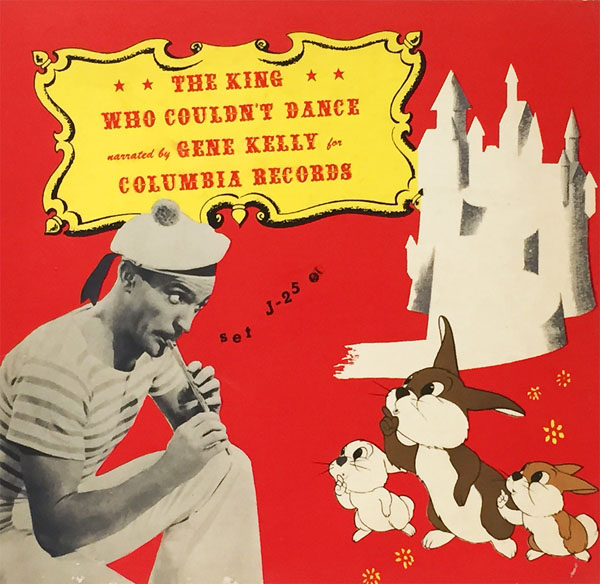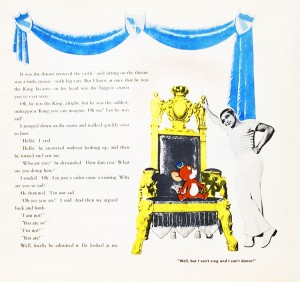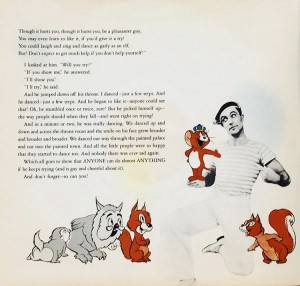The MGM musical classic Anchors Aweigh turns 70 in July, so here’s a spin through the record album based on its live-action/animated sequence supervised by Hanna and Barbera.

THE KING WHO COULDN’T DANCE (from MGM’s Anchors Aweigh)
Narrated by Gene Kelly
A Columbia Children’s Record Book J-25 (10” 78 RPM)
LP Reissues:
“Gene Kelly: Children’s Songs & Stories” Columbia Special Products P2-15024 (1979)
“Gene Kelly: The Happiest Birthday in the World” 51 West Records (1979)
Downloads on mp3: itunes and amazon.
Released in 1945. Writers: Isobel Lennart, Stanley Donen. Incidental Music: Lehman Engel. “The Worry Song” by Sammy Fain and Ralph Freed. Running Time: 7 minutes.
“The King Who Couldn’t Dance” sequence from the 1945 Technicolor MGM musical, Anchors Aweigh, is a staple of Hollywood montages that include the combination of live-action with animated characters, as well as profiles of William Hanna and Joseph Barbera. The sequence is the results of a perfect storm of the talent of every kind available on the MGM studios lot during its heyday.
The “lookit me, I’m dancin’!” exclamation of Jerry as the King could just as well be attributed to the confident, assured Gene Kelly, whose extraordinary athleticism and cinematic ingenuity (with nods to Stanley Donen and other collaborators) made him ideal to pair with cartoon characters. His agility rivals the capabilities of an animated figure. (Jerry’s dance moves, but the way, were worked out with Kelly by his longtime associate Carol Haney and used as a guide for animators Ken Muse, Ray Patterson and Ed Barge.)
Original Sequence from Anchors Aweigh
When this sequence is used as an excerpt, it usually cuts right to the castle and the overall story context is left out. There’s more to The King Who Couldn’t Dance than “The Worry Song”, just as there is more to Anchors Aweigh than the animated sequence. (I’ve grown to love the film as a whole much more than as a kid, when I wanted to get through all the other stuff–about Mr. Iturbi and Aunt Susie, a shy Frank Sinatra and the lady who played Mrs. Brown on My Favorite Martian — and see the cartoon part.) The record allows the whole story to be told, with less emphasis on the dance sequence, since it is an audio experience rather than visual. The accompanying book contains interesting composites of a photographed Kelly with spot-color illustrations. It is very likely that the MGM cartoon unit supplied the art.
 MGM did not release its film soundtracks on records until 1947, starting with Till The Clouds Roll By on their own label. Most recordings of film music were non-soundtrack re-creations. There were rare exceptions, most notably those of the Disney studio, whose soundtracks had a ten-year lead on MGM’s. At the time Anchors Aweigh was released to theaters, children’s records were hitting the height of their popularity; all the major labels had successful Disney titles and Capitol’s line of children’s records starring Bozo, Looney Tunes, Woody Woodpecker and others were just getting underway.
MGM did not release its film soundtracks on records until 1947, starting with Till The Clouds Roll By on their own label. Most recordings of film music were non-soundtrack re-creations. There were rare exceptions, most notably those of the Disney studio, whose soundtracks had a ten-year lead on MGM’s. At the time Anchors Aweigh was released to theaters, children’s records were hitting the height of their popularity; all the major labels had successful Disney titles and Capitol’s line of children’s records starring Bozo, Looney Tunes, Woody Woodpecker and others were just getting underway.
Under the direction of innovative producer Hecky Krasnow — who was responsible for Gene Autry’s hit versions of “Rudolph, the Red-Nosed Reindeer”, “Frosty the Snowman” and “Peter Cottontail”, among many other records—Columbia was a major contender in the genre. Kelly recorded several Columbia children’s 78’s, almost all of which were reissued over subsequent decades on various LPs and singles.
For The King Who Couldn’t Dance, an entire audio production was created around Kelly’s narration, with a full orchestra and two actors, who are not identified (Jerry does not sound like Sara Berner played him on the record). Very likely it was recorded in New York at Columbia’s West 57th Street studio, if only for the presence of New York music legend Lehman Engel, who wrote and conducted the original background score for the record. Engel was responsible for many important records for the label, in addition to major works for Broadway and television. He also founded the prestigious BMI Lehman Engel Musical Theater Workshop, whose illustrious participants include Alan Menken, Kristen Anderson-Lopez and Robert Lopez.
The Kelly/Jerry sequence has become so much a part of our cultural fiber that it was even given affectionate tribute with Stewie Griffin on The Family Guy:
GIVE A LITTLE LISTEN
“The King Who Couldn’t Dance”
This is the recording with the illustrations from the book bound into the album. Note that Kelly describes the fantasy world as “painted”, a clever way to convey the nature of the animated settings in a storybook-friendly way.
SPIN BONUS #1 Two more MGM-Hanna-Barbera animation/live-action sequences:
From “Invitation to the Dance”
From “Dangerous When Wet”
SPIN BONUS #2 Here’s the entire story book that was included in the original storybook album:










 GREG EHRBAR is a freelance writer/producer for television, advertising, books, theme parks and stage. Greg has worked on content for such studios as Disney, Warner and Universal, with some of Hollywood’s biggest stars. His numerous books include Mouse Tracks: The Story of Walt Disney Records (with Tim Hollis). Visit
GREG EHRBAR is a freelance writer/producer for television, advertising, books, theme parks and stage. Greg has worked on content for such studios as Disney, Warner and Universal, with some of Hollywood’s biggest stars. His numerous books include Mouse Tracks: The Story of Walt Disney Records (with Tim Hollis). Visit 






















































This is awesome, but I wish that Sara Berner had voiced Jerry for the LP version.
I was curious on who did Jerry’s voice on The King Who Couldn’t Dance Sequince on Anchors Away Sound like a female voice actress using a Brooklyn/Bronx “New Yarker” (New Yorker) type accent which sounded almost like Marjorie Hinds doing her Buzz the BeeScout character from Mr Bug Goes to Town/Hoppity Goes to Town.
Jerry’s voice in Anchors Aweigh was performed by Sara Berner, who was the voice of one of Jack Benny’s switchboard operators on his radio show, as well as many cartoon voices like, for WB, Mama Bear in Three Bears cartoons and the mother buzzard in the Bugs Bunny cartoon, “The Bashful Buzzard”.
Sara also voiced one line as Jerry in “The Zoot Cat”.
Sorry, Greg, but Mama Bear’s voice in those Jones cartoons, it’s from the start as one of Bea Benadaret’s very first WB voices her role (Mel Blanc as Pa in the first* then Billy Bletcher thru the last in 1951 as Pa, and Kent Rogers in the fiirst* then Stan Freberg thru 1951).
*1944’s “Bugs Bunny and the Three Bears”. Mel Blanc did some near-end screams for Pa in 1948’s “What’s Brewin’ Bruin” and 1949’s “Bear Feat”.
Since Bea played the other operator on Jack Benny’s show, in the sketches with Sara Berner, I guess confusion is understandable. (Their characters were called Mabel Flapsaddle and Gertrude Gearshift, Benny’s answer to “Brenda and Cobina,” similar characters on Bob Hope’s radio show.)
Originally Kelly and Donen wanted to use Mickey Mouse for Kelly’s partner, but Disney was not ready to lend his big star to a rival studio, even though he had earlier for Hollywood Party. Jerry makes much more sense; and as good as the Disney artists were at this stuff, their version wouldn’t have been any better than H/B’s.
Actually, it was Donald that was supposed to dance with Gene, not Mickey.
Most recordings of film music were non-soundtrack was re-creations rare exceptions, most notably those of the Disney studio, whose soundtracks had a ten-year lead on MGM’s.
Greg, I think your computer chewed this sentence up and spit it back out sideways. 🙂
For the sake of completeness, Columbia’s “The King Who Couldn’t Dance (The Worry Song)” was also issued on Harmony Records album HL-9552 on an LP titled ALL STAR CHILDREN’S ALBUM, VOL. 1. (Harmony was Columbia’s budget-priced label from the late 1950s into the mid ’70s.)
“The King Who Couldn’t Dance (The Worry Song)” was recorded in New York on July 28, 1945.
The soundtrack performance of “The Worry Song” has been issued on CD in recent years on a Turner Music/Rhino Records anthology titled ‘S WONDERFUL: GENE KELLY AT METRO-GOLDWYN-MAYER.
Very minor point, but MGM Records issued its TILL THE CLOUDS ROLL BY soundtrack album in fFebruary 1947, not 1948.
Hi Randy,
Yipes — thanks for catching that, and thanks for all the other info. I really appreciate how much folks add to Spin!
I don’t see anything affectionate in that Family Guy Gene Kelly/Jerry “tribute” at all. It’s just an appeal to an audience’s vague memory of an old cartoon (similar to South Park’s “I Love To Singa” “tribute”) and is anti-creative time filler. What else should we expect from a cartoon whose format is Married With Children meets the Simpsons with Kenner and Hasbro references. Just another sad example of how the bar continues to be lowered in a medium that should represent the highest art form humankind has to offer.
I can still see Jerry’s reflection in the floor.
Well, what do you expect? Since the late 80’s-early 90’s, most animation really hasn’t been aimed either at adults or kids. The target audience seems to be either/or (or a mixture of) adolescent snotpickers whose online remark “that’s so gheeyyy!” (in between fapping off at webcam videos) becomes the proverbial “butterfly’s wings” that causes heads to roll in Hollywood, and bored hipsters who just know they’re too smart for the room, and that EVERYTHING has to be a send-up of something they’ve seen before. These two groups are more alike in their views and attitudes than either will admit. So who else is left? Manga geeks. But that’s another story…
And yes, I do blame John K, Mike Judge, and Seth MacFarlane for most of the mess. I suppose I should include Matt Groening too, but his characters are by now as entrenched in the American scene as Disney’s or Schulz’s, so why bother.
Judy Gail Krasnow, daughter of the producer of this album, wrote this on FB:
“I remember that story and have the record to this day. Gene Kelly was truly a nice guy. As it says in my book, my mother’s day was made when he danced with her brief, but nevertheless, it happened.”
Okay. So when do we get “Jack and the Beanstalk” from Warner Archive?
My fantasy is that they pair it with “What’s a Nice Kid Like You . . .”
You’ve heard the anecdote about MGM asking Walt Disney to “Loan” Mickey Mouse for this sequence, only to be told by him: “Mickey Mouse has never appeared in an MGM film, and never will!”
Didn’t he remember HOLLYWOOD PARTY?
Giant of the industry though he was, Walt Disney was (first and foremost) a human being! As such, he was susceptible to making mistakes and having occasional lapses of memory, just like the rest of us! HOLLYWOOD PARTY had been a decade earlier, and yes, therefore I could see his having forgotten about it, given all of the other cartoon work he had done since then. Add to that the distraction of having the Federal Government virtually commandeering his studio during the War and his expansion at the same time into the field of live-action photography! Forget that he had done that brief one-shot in 1934? Understandable, IMO, given how VERY busy his working life was at the time!